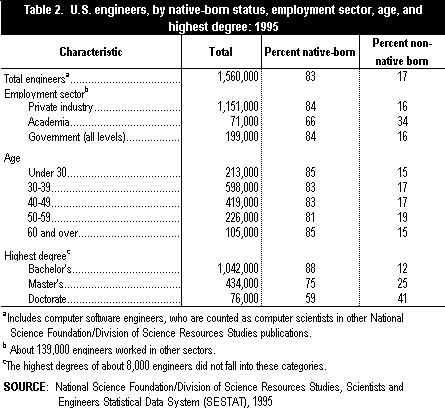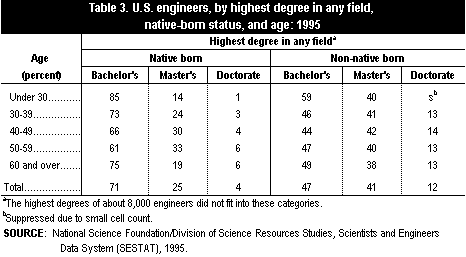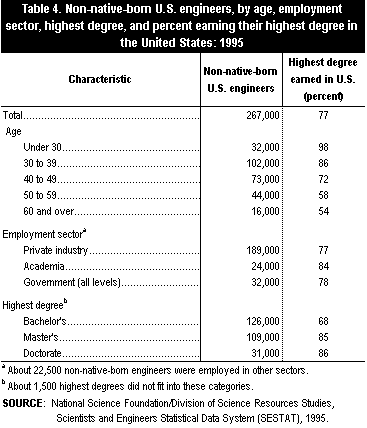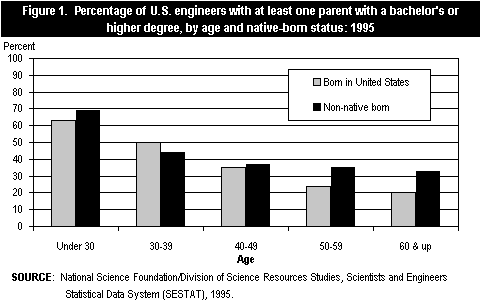
Directorate for Social, Behavioral
and Economic Sciences
NSF 99-327 February 11, 1999
Immigrant Engineers?

Current data suggest that while the number of immigrant engineers in the U.S. has increased over the years, their percentage of working engineers has changed hardly at all.
In the past, higher percentages of immigrants who became engineers in the United States had finished their formal education abroad compared to more recent immigrant engineers.
As of April 1995, about 15 percent of working U.S. scientists, and 17 percent of working U.S. engineers, were non-native born.[2], [3] These percentages significantly exceeded the 10 percent of the total U.S. employed population aged 25 and older that was born abroad.[4] This Issue Brief discusses further data on nativity of U.S. engineers, who make up almost 50 percent of the nation's science and engineering workforce (table 1).
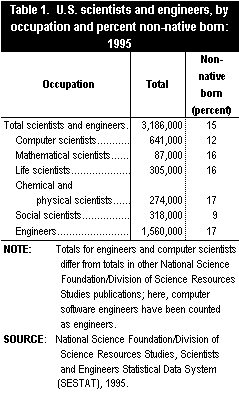 As
shown in table 2, the ratio of native-born to non-native-born
engineers is the same-about five to one-across 10-year age groups. By
contrast, increasingly large numbers of persons born abroad have
become engineers in the United States over the decades. While these cross-sectional
data reveal nothing about changes of individuals over time, they can be
used to infer changes about the population that have occurred over time.
Even allowing for some switching by non-natives from engineering to other
occupations, and for some emigration back to their native countries in
older age groups, the data in table 2 suggest that,
along with growth in the profession overall, the total number of U.S.
engineers born abroad has increased sharply over recent decades. But the
percentage of immigrant engineers was about the same when viewed across
10-year age groups of working engineers in 1995. In short, current data
suggest that while the number of immigrant engineers in the U.S. has increased
over the years, their percentage of working engineers has changed hardly
at all.
As
shown in table 2, the ratio of native-born to non-native-born
engineers is the same-about five to one-across 10-year age groups. By
contrast, increasingly large numbers of persons born abroad have
become engineers in the United States over the decades. While these cross-sectional
data reveal nothing about changes of individuals over time, they can be
used to infer changes about the population that have occurred over time.
Even allowing for some switching by non-natives from engineering to other
occupations, and for some emigration back to their native countries in
older age groups, the data in table 2 suggest that,
along with growth in the profession overall, the total number of U.S.
engineers born abroad has increased sharply over recent decades. But the
percentage of immigrant engineers was about the same when viewed across
10-year age groups of working engineers in 1995. In short, current data
suggest that while the number of immigrant engineers in the U.S. has increased
over the years, their percentage of working engineers has changed hardly
at all.
Educational Background
Non-native-born engineers have attained higher levels of education than
U.S.-born engineers: 12 percent of the former versus 4 percent of the
latter have a doctorate. Reflecting these higher levels of academic credentials,
non-native-born engineers comprise about one-third of the engineers working
in the academic sector-twice the level of their representation overall.
Table 2 shows that immigrant engineers have more often gone on to obtain a master's or doctorate degree than their representation in the occupation of engineering would suggest. Table 3 displays the highest degree levels of non-native engineers by age. Overall, 53 percent of non-native versus 29 percent of native-born engineers have attained a postbaccalaureate degree. In all age groups including the youngest-many of whose members have not finished their education-non-native engineers have reached higher levels of education than their native-born colleagues.
Table 4 shows a sharp increase from older to younger groups in the percentage of engineers born abroad who earned their most recent or highest[5] degree in the United States. This pattern suggests the speculation that younger immigrant engineers have taken a quite different route into U.S. engineering practice than their older colleagues: more often, they have come to the United States to obtain or finish their education and have subsequently become practicing engineers. In the past, larger percentages of immigrants who became engineers in the United States had finished their formal education abroad. The table also shows that the higher their degree level, the higher the proportion of immigrant engineers who earned that degree at a U.S. college or university.
Socioeconomic Background
Parental education has traditionally been used as one measure of an individual's
socioeconomic background, and the relationships between parental levels
of education and careers of their children have been analyzed in studies
of intergenerational social mobility.[6]
NSF data reflect increasing levels of education throughout the general
population both in the United States and abroad.
Figure 1 shows that the parents of older engineers were much less likely than those of younger engineers to have obtained a college degree. Thus, among engineers 50 years and older, less than one-fourth of native-born engineers, and about one-third of non-native-born engineers, had at least one parent with a baccalaureate or higher degree. Sharp increases in parental education are evident in each younger cohort, especially among the baby boomers aged 30-49. The percentage of native-born engineers in their 30s with at least one parent with a 4-year degree was twice as high as for those in their 50s. And in contrast to older engineers, native-born engineers in younger cohorts are about as likely as immigrant engineers to come from parents who have already attained the socioeconomic status that a 4-year degree brings.
Summary
NSF data indicate that:
- The United States has relied on people born outside the country for its engineering workforce, but at about the same rate as the growth in the occupation of engineering as a whole.
- Younger immigrant engineers are more likely to have received their highest degree in the United States than their older immigrant colleagues.
- Immigrant engineers have more often obtained postbaccalaureate degrees than native-born engineers.
- Like native-born engineers, immigrant engineers have increasingly been born of a parent with a high educational level.
- Among younger cohorts of engineers, U.S.-born and non-native-born engineers had parents with more similar socioeconomic status; among older cohorts, non-native-born engineers more often came from a parent with a higher level of education.
This Issue Brief was prepared by:
Lawrence Burton
Division of Science Resources Studies
National Science Foundation
4201 Wilson Boulevard, Suite 965
Arlington, VA 22230
703-306-1774 x6913
E-mail: lburton@nsf.gov
SRS data are available through the World Wide Web (http://www.nsf.gov/statistics/). For more information about obtaining reports, contact pubs@nsf.gov. or call (301) 947-2722. For NSF's Telephonic Device for the Deaf, dial (703) 306-0090. In your request, include the NSF publication number and title, your name, and a complete mailing address.
